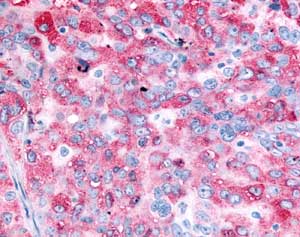
Popular topics

-
References
Cohen S (2008). Origins of Growth Factors: NGF and EGF. J Biol Chem. 283, 33793-33797.
Henson ES and Gibson SB (2006). Surviving cell death through epidermal growth factor (EGF) signal transduction pathways: Implications for cancer therapy. Cell Signal.18, 2089-97.
Modjtahedi H and Essapen S (2009). Epidermal growth factor receptor inhibitors in cancer treatment: advances, challenges and opportunities. Anticancer Drugs. 20, 851-5.
Sigismund S et al. (2017). Emerging functions of the EGFR in cancer. Molecular Oncology.12, 3-20.
Why EGF R is an Attractive Target for Cancer Therapy

Epidermal growth factor receptor (EGF R) was the first receptor tyrosine kinase to be discovered. Featuring in around 70,000 publications, its structure and function are arguably well understood. However, its emergence as a therapeutic target for cancer means that it is still a hot area of research. In 2017 there were over 5,500 publications recorded in PubMed for EGF R. In this blog we examine the history of EGF R, the EGF R family and its function along with how EGF R promotes cancer development.
A Nobel Prize Winning Discovery
While working in Rita Levi-Montalcin’s lab, Stanley Cohen discovered nerve growth factor (NGF). This discovery shaped the direction of Cohen’s research career and would later result in him discovering EGF R. Cohen and Levi-Montalcin shared the Nobel Prize in 1986 for their discovery of growth factors.
Cohen’s discovery of epidermal growth factor (EGF) came from examining why crude extracts of male mouse salivary gland induced early eye opening, while NGF did not have the same effect. He went on to isolate EGF as the protein responsible for the effect. In 1975 he showed that I-125 labeled EGF could bind to the surface of fibroblasts and stimulate growth, confirming that there must be a receptor for EGF (Cohen 2008).
EGF R Family
Only discovered in 1978, the EGF R family is comprised of four members:
- EGF R/ ErbB1/HER1
- ErbB2/HER2/Neu
- ErbB3/HER3
- ErbB4/HER4
This family of receptors dimerize upon ligand binding. This dimerization of the receptors triggers phosphorylation of the receptor which enables the recruitment of adaptor proteins that in turn trigger downstream signaling pathways.
Unlike other family members, ErbB3 and ErbB2 are believed to be co-receptors. ErbB3 has an inactive kinase domain and ErbB2 appears unable to bind ligands.
Seven ligands have been identified that bind EGF R. These are epidermal growth factor (EGF), transforming growth factor alpha (TGF-α), heparin-binding EGF-like growth factor (HB-EGF), betacellulin, amphiregulin, epiregulin and epigen. Some of these ligands can also bind to other members of the EGF R family.
EGF R and Cancer
The discovery that the v-ErbB oncogene of the avian erythroblastosis virus was a mutant homolog of human EGF R was the first link to the role of EGF R in cancer development. Mutations in EGF R have since been associated with a number of different cancers including non-small cell lung cancer, breast cancer, metastatic colorectal cancer and glioblastoma. Activation of EGF R leads to increased cell proliferation and cell growth and decreased programmed cell death (apoptosis). This effect is due to EGF R triggering different signaling pathways:
- RAS/ERK pathway: the ERK pathway is activated through Grb2 or Shc binding the phosphorylated receptor and then recruiting son of sevenless (SOS) then activates RAS, which in turn activates RAF-1. RAF-1 phosphorylates MEK1 and MEK2, which activate ERK1 and ERK2, respectively. These then activate transcription factors which promote cell growth and inhibit apoptosis (Henson and Gibson 2006)
- PI-3 kinase/AKT pathway: PI-3 kinase is recruited to the activated receptor and phosphorylates PIP2, which activates AKT, and in turn anti-apoptotic proteins. Other proteins activated by AKT promote cell growth and survival (Henson and Gibson 2006)
- JAK/STAT pathway: JAK phosphorylates STAT proteins located at the plasma membrane. The STAT proteins then move to the nucleus where they activate the transcription of genes associated with cell survival (Henson and Gibson 2006)
EGF R and Personalized Medicine
The role of EGF R in the development of many cancers has made it an attractive therapeutic target. Several drugs that target EGF R have already been developed and licensed to treat cancer (Modjtahedi and Essapen 2009). Examples include Trastuzumab (Herceptin) for breast cancer, Cetuximab (Erbitux) for squamous cell carcinoma of the head and neck, Erlotinib (Tarceva) for non-small cell lung cancer and Panitumumab (Vectibix) for metastatic colorectal carcinoma.
Recent studies have identified new roles for EGF R in regulation of autophagic and metabolic pathways (Sigismund et al. 2017). Since these pathways are often activated in cancer cells it could give them a further survival advantage and increase their resistance to cancer therapy. Further understanding of EGF R activation and signaling will likely lead to the identification of new targets for drug design and improved cancer treatment strategies. EGF R and drugs that target the receptor and/or pathway will continue to be an important focus of scientific research for some time.
References
Cohen S (2008). Origins of Growth Factors: NGF and EGF. J Biol Chem. 283, 33793-33797.
Henson ES and Gibson SB (2006). Surviving cell death through epidermal growth factor (EGF) signal transduction pathways: Implications for cancer therapy. Cell Signal.18, 2089-97.
Modjtahedi H and Essapen S (2009). Epidermal growth factor receptor inhibitors in cancer treatment: advances, challenges and opportunities. Anticancer Drugs. 20, 851-5.
Sigismund S et al. (2017). Emerging functions of the EGFR in cancer. Molecular Oncology.12, 3-20.
You may also be interested in...
















